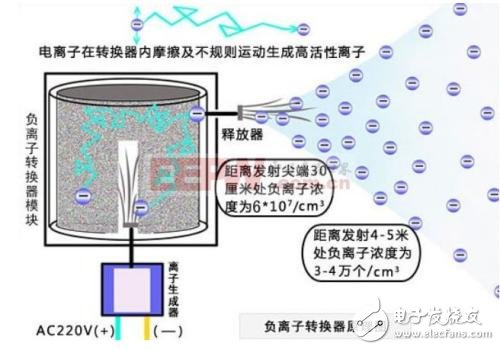Air negative ions, often referred to as "air vitamins," play a crucial role in human health, much like sunlight and oxygen. Scientific studies have shown that the concentration of negative ions in the air is a key factor in determining air quality. When present in appropriate amounts, these ions help remove dust, sterilize the air, and purify it. They also activate oxygen molecules, forming oxygen anions, which contribute to better air quality and overall well-being.
A negative ion generator is a device designed to produce air negative ions. By using high-voltage corona discharge, it increases the number of negative ions in the air, thereby improving air quality and promoting physical health. Known as the "vitamin of the air," this technology has been widely used in medical and daily life applications. Clinical studies have demonstrated its beneficial effects on the respiratory, circulatory, and nervous systems. The most advanced type of negative ion emitter is the nano-fullerene tip, which produces pure negative ions. Research suggests that small, eco-sized negative oxygen ions can easily cross the blood-brain barrier, offering significant health benefits.

**Working Principle**
The principle behind a negative ion generator involves boosting low voltage through a high-voltage module using a pulse oscillating circuit. This process generates a continuous DC negative high voltage, which is then used to create a corona discharge at the carbon fiber tip. This discharge emits a large number of high-speed electrons (eâ»), which are quickly captured by oxygen molecules (Oâ‚‚) in the air, forming negative ions. This mechanism is similar to natural phenomena, such as during thunderstorms, when negative ions are also produced.
A typical negative ion generator consists of three main components: the negative ion generating unit, the power circuit, and the blower. These parts work together to ensure efficient production and distribution of negative ions.

**Negative Ion Generating Device**
Although there are various forms of negative ion generators, their working principles remain consistent. For example, in a cylindrical model, the outer structure is made of a metal cylinder with a wire running along its axis. The cylinder and wire are connected to the positive and negative terminals of a high-voltage power source, creating an electric field inside the cylinder. Free electrons in the air accelerate under the influence of this field, colliding with other molecules and causing ionization. This leads to the formation of both positive and negative ions, which accumulate in the space around the electrode.

The generation of negative ions primarily occurs in regions with a strong electric field near the negative electrode. The stronger the electric field, the more negative ions are produced, resulting in a higher-quality generator. However, if the electric field becomes too intense, it may cause excessive electron escape and even spark discharge, which can be dangerous.
**Power Circuit**
The figure above shows a high-efficiency open-type negative ion generator that uses thyristor inverter technology and floating discharge needles. This design offers simplicity, effectiveness, and safety. It operates efficiently across a wide voltage range (160V to 250V) and consumes only about 1W, allowing for long-term continuous operation.
The 220V AC input is first rectified and current-limited by VD1, VD2, R1, and R2. The resulting pulsating DC controls the switching of VS, generating oscillations. The signal is then stepped up by transformer T and rectified by VD3 to produce a negative high voltage of approximately 10,000 volts, which is used to generate negative ions through air discharge.
**Blower Device**
Inside the metal cylinder of the negative ion generator, a large number of positive and negative ions are created. While some of these ions gradually diffuse out due to molecular motion, most are attracted to the electrodes under the influence of the electric field. To ensure that the negative ions reach the surrounding environment effectively, a blower is typically added. This device helps distribute the generated negative ions throughout the space, maximizing their health benefits.
**In Summary**
When evaluating the quality of a negative ion generator, several factors should be considered. First, the size of the strong electric field region that contributes to ion generation is important. Second, the voltage applied to the electrodes must be appropriate for optimal performance. Lastly, the presence of a blower ensures that the generated ions are efficiently dispersed into the environment. These elements collectively determine the effectiveness and reliability of a negative ion generator.
Elevator Control Systems,Mr Elevator Controller Cabinet,Main Power Supply In Cabinet,Elevator Control Cabinet
ZHONG HAN INTERNATIONAL TRADE CO., LTD , https://www.cck-ht.com
![<?echo $_SERVER['SERVER_NAME'];?>](/template/twentyseventeen/skin/images/header.jpg)